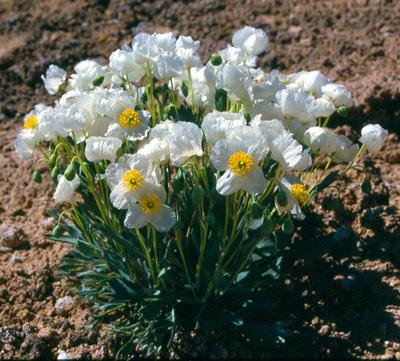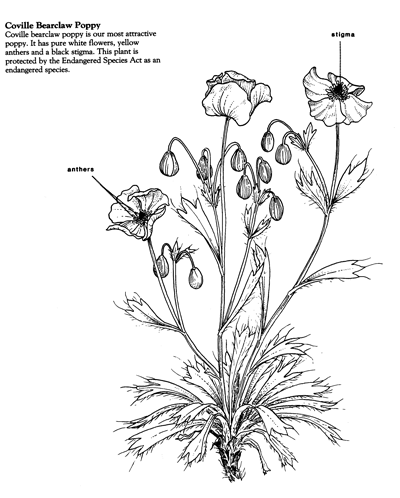UNPS initiates action in early 1983
UNPS conservation chair Tony Frates initiates contacts with various state and federal agencies as well as
with botanists in March of 1983 after the poppy is identified as the "most endangered" species in the Utah
flora. Activity is continuous throughought 1983 and Dr. Duane Atwood, the rare plant committee chair, plays a vital role.
State of Utah Dwarf BearClaw Poppy Recovery Plan (approved by land board 12/83)
This document was the culmination of UNPS efforts with respect to working with the state of Utah
in gaining their cooperation and as outlined/recommended in the federal recovery plan
Sept 30, 1983 application - page 1/main application
State Of Utah (Natural Resources & Energy, State Lands & Foresty) letter of October 5, 1983
signed by Kevin S. Carter (then Land Specialist) to the Galen Buterbaugh, U.S. Fish & Wildlife Service (Denver)
Note in the first page Kevin Carter states:
|
We feel a need to demonstrate that we can effectively manage lands
on a "School Trust" basis and still consider and protect other
environmental factors.
|
|
We feel that we will be able to manage and provide as much
protection to this endangered species as any federal agency could
provide.
|
SL Tribune article by Jim Woolf dated 11/8/1983: Utah Plans Steps to Save Endangered Poppy
Part 1
Part 2
State of Utah/Matheson letter to BLM of 2/3/84
affirming the state concept of ACEC's
Letter (one page)
USFWS recovery plan approved in 1985
Recovery plan was approved December 31, 1985 (it however has never been funded by the USFWS).
Monitoring efforts begin in 1985
In 1985 Kevin Carter (State Lands & Forestry) initiated some informal monitoring studies. This was
the beginning of an effort that later led to UNPS initiating a full scientific study to better understand
the populations. Prior to President's Day, 1985, materials were prepared and provided to Kevin Carter for
his possible use in patroling (President's Day is a heavy use/ORV day at the White Dome site).
UNPS field trip - early May, 1985
Dave Wallace of UNPS set-up a field trip after hearing a talk by Larry England and various UNPS/local Sierra Club
Chapters met with Kevin Carter and signs at White Dome were re-posted.
UNPS The Endangerd Dwarf Bearclaw Poppy brochure written/designed by Tony Frates in early 1986
Side 1
Side 2
State efforts continue in 1986
Two days prior to President's Day, 1986, signs at White Dome were re-posted. An organized motorcycle event
was again this year held and the state assisted in monitoring activities.
UNPS establishes a bear poppy study committee
Chaired by Dick Page, UNPS initiates a proposal for the study of the species which an ad hoc study
committee reviews and provides input; input from the academic community is sought.
UNPS produces the filmstrip To Save A Species: Dwarf Bearclaw Poppy (1988)
Attempting to fulfill its mission and as recommended by the draft recovery plan, a filmstrip is prepared, completed and distributed to schools and libraries primarily in the St. George area by UNPS volunteers.
Here are some scans of some of the 45 slides from that presentation:
Citation and library card:
Utah Native Plant Society. 1988. To save a species: dwarf bear claw poppy [46 fr. col., cassette].
The survival of this endangered plant, growing only in Washington County, Utah, is dependent upon the cooperation of the people of Utah.
CONTENTS: -filmstrip, cassette tape, photo, script and information materials for the teacher.
BLM letter letter of 3/30/1989 in reply to Harper/Nelson letter above
Letter
Threatened Bear Claw Poppy Receives Help from The Nature Conservancy's GreatBasin newsletter, fall 1990
Page 1
SL Tribune article by Jim Woolf dated 5/19/1991: Program Surveys Rarest Plant in Utah: Dwarf Bear-Claw Poppy Near St. George
Part 1 (Ben Franklin/poppy pictured; documents ongoing ORV damage)
Salt Lake Tribune article dated 6/02/1996 by University of Utah botanists Michael D. Windham and Loreen A. Woolstenhulme: Bull-Headed Humans Threaten to Stamp Out Rare Bear-Claw Poppy
Part 1
Part 2
Deseret News article by Lucinda Dillon published 7/1/1998: Poppies, soil, other quirks pose natural hurdles to development
Quote from a BLM official with respect to building on the habitat of gypsiferous plants like Arctomecon humilis:
|
Build a house on it when wet and the ground will shrink and collapse beneath the structure. Build when it's dry, and "it's literally strong enough to split houses in half when it expands,"
|
These warnings however have largely gone unheeded.
Bearclaw Poppy Then and Now - A 20 Year Retrospective
Dave Wallace photos documenting severe
state of habitat decline on the White Dome (state owned/SITLA managed) and Atkinville (primarily state owned
and nearing complete extirpation) lands comparing how they looked in the mid-1980's compared to how they
looked in May of 2004.
Dwarf Bear Poppy Day declared in St. George (May 3, 2007)
From the May 3, 2007 St. George City Council Minutes:
|
PROCLAMATION: Marilyn Davis advised that Washington County is the only place in the world the Dwarf Bear Claw Poppy grows, and it is in full bloom now.
|
|
Mayor Pro Tem Orton read a proclamation declaring the second Saturday in May as Dwarf Bear Claw Poppy Day in the City, and presented the proclamation to Ms. Davis.
|
The Nature Conservancy Congratulates St. George on Dwarf Bear Poppy Day (May 4, 2007 article)
Saturday May 12, 2007 was the first Dwarf Bear Poppy Day in St. George.
TNC Announces Preserve Purchase (June 25, 2007)
The Nature Conservancy announces the purchase of a 55 acre reserve at White Dome as part of an overall plan to acquire 800 acres.
Some limited habit for Pediocactus sileri (also a federally listed plant species) is included.
In the September 2007 edition (vol. XXXII No.3) of the U.S. Fish & Wildlife Service's Endangered Species Bulletin, the article
Conserving a Natural Utah Treasure by Elaine York, TNC's Western Regional Director, provides additional details.
TNC White Dome Preserve Survey May 2008
According to a report from The Nature Conservancy, a May 2008 survey on its new 55 acre survey
in the beleaguered White Dome area revealed an above-average bloom this year and above normal seed production.
2007-2008 was an above average water year, or at least better than what still seems to be an extended drought.
These "better" years are essential for the species to have any hope of longer term survival since its seeds are
known to be long-lived.
Construction begins on new St. George Aiport (10/17/2008)
This project may mark the beginning of the end for dwarf bearclaw poppy and other
rare plant species in the St. George area.
Human-mediated pollination may be required to ensure the survival of the species (2014)
Researched published by Tepedino et al (2014) predicts that human intervention in assisting cross-pollination may be necessary
in light of the fact that "the polinator community appears to have changed dramatically" over the past two decades.
New population found in 2016
A small (so far, under 100 plants) was found on private property in 2016 that
should have already been designated as critical habitat based on Nelson and Harper (1991). In that article they indicated that:
|
For purposes of habitat protection, portions of the Purgatory Flat area should receive status similar to A. humilis sites.
|
Presumably this area was previously carefully looked at and plants most likely became re-established due to seeds in the soil bank.
Five year review published on 9/29/2016 by USFWS
The review is available here: Dwarf Bear-Poppy 5-Year Review
The review however was overdue by almost five years.
It barely mentions some of the disruptive occurrences created by SITA development and the road through White Dome.
Pollinators of Arctomecon humilis are in trouble (2017)
As was also discussed at this year's rare plant meeting (held on March 7, 2017 at the Natural History Museum of Utah on the University of Utah campus) and based on research published in September of 2017, the invasion of Africanized honey bees
has had a deleterious impact on the native pollinators of A. humilis including Perdita meconis
which now may be absent, as well as the native Eucera quadricincta.
The abstract concludes: "Arctomecon humilis now appears to depend mostly on an invasive species for pollination." (Portman et al, 2017).
St. George News article features research and conservation concerns (May 2, 2018)
An article written by Jeff Richards of the St. George News entitled
What to do if you see bear claw poppies on the trail outlined the work of Dixie State University's Dr. Erin O'Brien and her students
over the past several years to learn more about the poppy's phenology and conservation status. Dr. O'Brien has also been a regular participant in annual Washingon County rare plant meetings organized by the USFWS.

